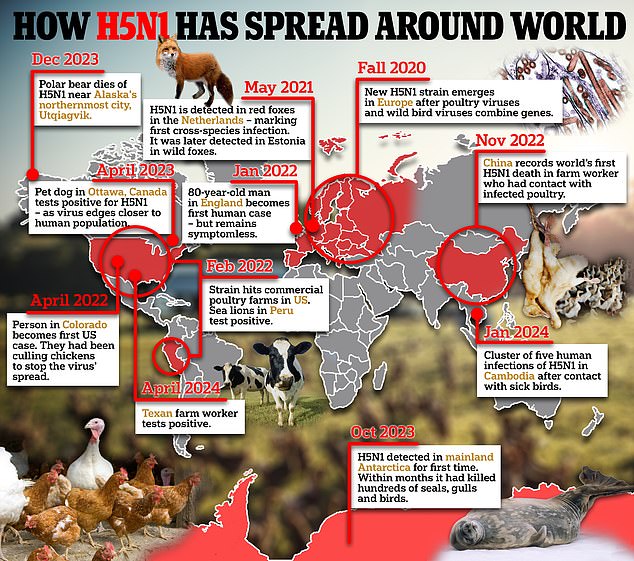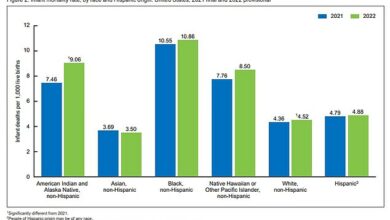‘This is how pandemics happen’: Scientists warn after terrifying developments in Missouri





Last week, a worrying development in the H5N1 bird flu outbreak occurred in Missouri.
For the first time, a patient was diagnosed with the virus despite having had no contact with sick birds, cows or other animals.
The worst-case scenario is that the patient got the virus from someone else and the virus is silently spreading among Americans.
While unlikely, Dr. Kruitka Kuppali, a spokesperson for the Infectious Disease Society of America and a former director of the World Health Organization, warned this week: “This is how pandemics happen.”
Experts told DailyMail.com the situation is “somewhat similar” to how previous pandemics have emerged, but stressed there is “no reason to panic yet”.

Experts told DailyMail.com it is highly unlikely, but that bird flu appears ‘somewhat similar’ to the early days of the Covid pandemic (stocks)

The above shows how bird flu is getting closer to human transmission in the US
For example, the 2009 swine flu pandemic was first discovered in a similar way, when two children in California were found to have never come into contact with pigs or with each other.
The early Covid outbreak in China also began with cases of a mysterious flu-like illness and in Wuhan there appeared to be no connection.
Missouri health officials won’t say how the state’s “patient zero” became infected, saying only that the risk to the general public remains “low.”
However, experts are concerned about the case and the lack of transparency.
Dr Raj Dasgupta, chief medical adviser for Fortune Recommends Health, told DailyMail.com: ‘If health authorities are not transparent, it can cause problems.
‘If people don’t get clear information, they may not know what symptoms to look out for, what measures to avoid or how to protect themselves.
‘This can cause confusion, spread false information and create unnecessary fear, making it more difficult to deal with a potential health threat.
“Health officials must share clear and accurate information quickly to prevent outbreaks and maintain people’s trust.”
The Missouri case was discovered through the state’s seasonal flu surveillance system, which tracks flu activity based on tests of symptomatic patients.
Because bird flu does not always cause symptoms, it is possible that there are more sick people who do not get tested.


A check mark indicates that the food has tested positive for bird flu, while a cross indicates that the food has been tested for bird flu but the virus was not found.
Another theory is that the patient drank raw milk that was contaminated with the virus.
According to the National Institutes of Health (NIH), raw milk is becoming increasingly popular and studies have shown that H5N1 particles can persist in it for up to five weeks when stored in the refrigerator.
About four percent of Americans (nearly 11 million people) consume raw milk and raw cheese. These products do not undergo pasteurization, a process that uses heat to kill about 99.9 percent of pathogens.
In April, the WHO warned that bird flu had been found in “very high levels” in samples of raw milk, but that pasteurised milk, which is standard at major retailers, was safe to consume.
In recent years, fitness enthusiasts and wellness influencers have been calling raw milk a superfood, claiming it contains more vitamins and minerals than pasteurized milk and is better tolerated by people with asthma and lactose intolerance.
However, the CDC classifies raw milk as “one of the riskiest foods,” stating that the bacteria it may contain “can pose serious health risks to you and your family.”
Dr Thomas Peacock, an influenza virologist at the Pirbright Institute in the UK, said Statistical news: ‘The obvious question I would ask is: Have you ruled out that it’s not someone who has a big container of raw milk in their refrigerator? Because that just seems like an obvious route for a cryptic infection.’
Lisa Cox, spokeswoman for the Missouri Department of Health, said the patient did not report drinking raw milk.
However, it is unclear whether the authorities actually investigated this or whether they asked the patient directly.
Dr. Peacock also warned that the patient could have had an outdoor cat, as several farm cats have been killed by the virus this year. He noted that if the patient had a cat, it would have been fed raw milk from a
Raw milk is not illegal in Missouri, but it can only be legally purchased from licensed farms or farmers markets.
Raw milk isn’t the only food that carries risks.
Dr. Darin Detwiler, a food safety expert at Northeastern University in Boston and a former adviser to the FDA and USDA, previously told DailyMail.com that foods containing undercooked meat or eggs could also contain tiny particles of bird flu and other deadly diseases.
He noted that while the risk is “very low,” cooking these foods thoroughly is essential to kill any pathogens. For example, searing the outside of a steak “should be good enough to kill a pathogen even if the inside isn’t cooked well,” as bird flu could move to the inner part of the beef.
Dr. Detwiler also advises clients to be careful with eggs that have soft yolks, such as fried eggs, poached eggs, soft-boiled eggs, and sunny-side up eggs.
“In the case of bird flu, eggs should be cooked until both the white and yolk are firm. This will allow the egg to reach a temperature that will kill any viruses,” the chef said.
According to the USDA, eggs should be cooked to a minimum temperature of 160 degrees Fahrenheit (71 degrees Celsius).
Dr. Eve Elizabeth Pennie, GP and medical officer at Drug surveillancetold DailyMail.com that ‘although transmission of bird flu through food is not common, following safe food practices is always the best way to protect yourself and your family.’
Dr Dasgupta also noted that while it is highly unlikely that bird flu will be transmitted from person to person, its spread could pose a serious risk of an outbreak.
“If the virus is spreading between people, it could mean that the virus has changed or adapted, making it easier to spread. That could lead to larger outbreaks or even a pandemic,” he said.




